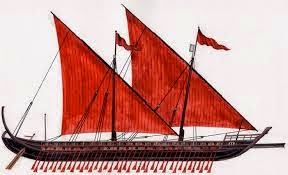Mediterranean and Indian Ocean regions
Strong metal tools, initially made of bronze, were obviously a major element in the development of shipping technology. They were available in central Europe by the early fourth millennium bc and were introduced into the Mediterranean and Near East probably a little later. By the latter part of the third millennium BC wooden ships large enough to carry cattle were being used to ferry animals between the mainland and Cyprus. Oars and paddles were the methods of propulsion employed by the earliest seafarers, but by the end of the fourth millennium BC the sail was being used in the Mediterranean, the Red Sea and the Indian Ocean. We cannot say where or when it was first developed, although it seems likely that there were several, roughly simultaneous ‘inventions’ of the sail in these regions. The idea of attaching a broad wind-trap to a post or pole, fixed to the body of a ship, in order to use the wind to propel the vessel is taken so much for granted nowadays that we can easily overlook how ingenious and bold the concept must have seemed to those who saw it for the first time. The sailing ship is one of humankind’s great technical innovations, to be ranked alongside the potter’s wheel or the printing press in the history of civilization. Wooden sailing ships were to be the preferred means of maritime transport in the Mediterranean and adjacent regions for nearly two thousand years.
By the middle of the first millennium BC the two main methods of propulsion, sail and oars, were in widespread use across the Mediterranean region and beyond. Ship designs had begun to specialize according to function. The typical seagoing vessel of the first millennium ad might use oars or sails or both. There were many variations in the size, the depth, breadth and length of its hull, according to the needs of the ship’s owner. The long, multi-level oared warship with a ram on its prow, best exemplified by the celebrated trireme and quinquereme, is the type of vessel most readily associated with ancient seafarers. Yet these impressive-looking galleys with their huge crews of oarsmen were only for naval use. Less elegant, shorter, more rounded ships with a greater cargo capacity would have been commonplace in the harbours of the Mediterranean, the Red Sea or the Persian Gulf. Warships were far less specialized outside the Mediterranean, where rougher seas and stronger winds made the oared galley less effective and where naval activity was less regular.
The number of masts and the types of sails used by ancient mariners varied considerably, as did the techniques of building, rigging and sailing seagoing ships. By the third century AD the square sail was being gradually supplanted by the triangular, lateen sail, which, together with multiple oars, offered considerable advantages in the relatively calm conditions of the Mediterranean. A major advantage of the lateen sail is that it can be cut much larger and baggier than a square-cut sail, and thus it will catch and use the wind more efficiently, especially when sailing to windward. Exploitation of the monsoon winds, which was widespread from c.600 BC onwards, led to much larger, sturdier sailing vessels in the Arabian Sea and Indian Ocean. From an early stage, therefore, the shipbuilders of the Arabian Sea produced sewn plank boats with lateen rigged sails. These were the ancestors of the dhow, a term used by Europeans for a range of sailing vessels. Looking further afield it is not surprising that light, bamboo and timber craft with outriggers were very popular in South-east Asia, especially for use in shallow seas and among the islands.
In these seas and elsewhere experiments with sailing rig, steering methods and other aspects of seafaring gradually produced a diversity of ships built and sailed according to the dictates of local conditions. In general terms the factors influencing maritime ship design were similar throughout the world. They include the range of locally available materials, cargo sizes and weights, costs of crews (important for both merchant and naval requirements), the typical strengths of winds and currents and the depths of coastal waters. The interplay of these factors was complex. For example, larger cargo ships were produced where the cargoes were usually in bulk (e.g. timber, cloth, grain and cheaper metals), whereas smaller vessels might be favoured for luxury or high value cargoes (e.g. gold and ivory). But very large cargo ships were not common until more recent times, partly because individual merchants or ship owners lacked the resources and capital to produce them and run them effectively. Only the very rich or the ruling elites could afford to use them. A compromise was often sought in terms of mixing bulkier and smaller cargoes so that the typical merchant ship or trading vessel of the pre-industrial era was of a modest size and crew.
